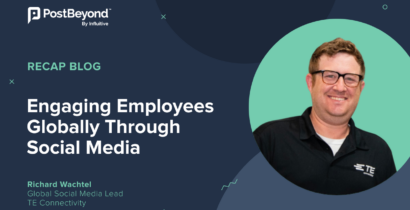We recently hosted Caleb Gardner, social media strategist and co-founder of 18 Coffee, to share his perspective on how crises accelerate the need for digital transformation.
In case you don’t know who Caleb Gardner is, he’s most notable for leading Barack Obama’s social media strategy during his presidency. During his time serving the Former President of the United States, he managed his 110M+ Twitter followers and has had to respond to a range of unforeseen crises. He shared his thoughts on how leadership should react to a crisis and how marketers should respond on social media. And of course, he talked about his experience working for Barack Obama.

In short, the webinar covered a high-level look at what companies need to do to survive during a crisis. To give you a glimpse, here are the key takeaways from the webinar.
Q: How do you make change a core competency in companies?
For companies to adopt digital, there are many forward-thinking initiatives needed to respond to consumer demand. Shifting audience attention requires brands to be on multiple platforms such as digital and social media.
However, Caleb has found through his work at 18 Coffees that time and time again; organizations could not change fast enough to reach their full potential.
Caleb said that the most significant roadblocks were a lack of change management and organizational development. By addressing the barriers, they would have to look behind the organization’s curtain to see where will the strategy fall. Companies need to recognize that change is not going to come and go. Whether it’s training people to adopt new competencies or access to data – a lack of desire to change is often the biggest roadblock.
He stressed that it wasn’t about starting at Point A and striving towards a fictional Point B. Nor was it about the four to five things companies need to do to get to Point B. Instead, companies need to recognize that Point B doesn’t exist.
“Things change so much. If we’re not building change as a core competency and getting in the reps of being able to test and learn quickly then being able to adapt to new opportunities in the marketplace, we will get left behind even if we think we’re moving fast.”
He recommends getting executive leadership within one room for a co-creation and vision exercise. At 18 Coffees, Caleb uses an activity called The Cookie Monster Moment. “Everybody knows what the Cookie Monster wants. It’s a very tangible desire that everybody gets. We get everyone in a room together to share their tangible desire and talk about the future state and get everyone to understand in an easier way to get to what the cookie monster truly wants.”
Q: How should a leader respond on social media during a crisis?
How a leader responds on social media is a very delicate topic. Caleb tends to think that leaders, as representatives of their company, create a perceived distance between the brand and personal opinions. This is a fool’s errand, he says, “I think the best form of leadership is when your personal values align with our values, and we want someone to speak up about those values in the marketplace.”
For C-suite leadership, it’s a delicate balance, especially in public companies. This is because C-suite leaders represent the entire company, the interest of their employees, shareholders and stakeholders.
There are many good examples such as Richard Branson, Elon Musk, Ramon Laguarta, Tim Cook. They are leaders who have taken a strong stance based on who they are and what their company stands for. Mostly it has worked in their favor for brand recognition, but sometimes there may be a bit of a backlash.
Caleb drew from his experience leading Barack Obama’s social media program, so he has a particular perspective on the subject. But in the last few years, he has seen more CEOs start becoming forward-looking and learning into social issues.
“I think the CEOs that do it really well are doing it based on a demonstrated history of what their company cares about. They’re leaning into it in a way that does not feel hollow because their company has a proven record in that area.”
To have a proven record means what industries you belong to, what products you create, what your core value system is. There are numerous areas that a company can lean into. For example, how their supply chain works or where their employees are based are factors to take consider. And if the company has done that, then the CEO speaking up for the issue should be natural.
Q: How should companies build a movement and social connections as a community?
We’re in a moment in history where building community is even more critical because we’re missing social connection. Companies recognize that we’re in a moment in time where we are more isolated than we have ever been.
Caleb has launched specific training on building community as an industry-specific organization. And through his experience, you can’t paint with a broad brush.
For B2B companies, building social connections is usually dependant on relationships and a high-touch sales model. There’s often a mutual relationship between customer and company based on an exchange of value.
For B2C companies, there’s an opportunity to building a long-tail community of passionate advocates for your products and services. Or a private social group and community management for specific members.
“There’s now a time of opportunity to think about multi-stakeholder engagement when it comes to brand community building. Not just with consumers and not just with customers but how do we do this with our employees? How do we do this with our community? How do we do this with our shareholders?”
If you’re focusing on reputation and equity building, then you should be engaging all stakeholders, not just with your customers.
The Wrap Up
It’s not every day that you get to do a live webinar with the person behind Twitter’s largest following. We ere delighted to host Caleb Gardner during our webinar and for him to share his perspective with everyone.
One interesting question came from the audience “What Barack Obama would do if he was the leader of a Fortune 100 company?”
Caleb’s response reflected Obama’s core philosophy, “you can’t forget the people who put us in power when we get there.” He could envision Obama taking care of his people and rallying everyone to become keepers of the community. He would ensure everyone aligned to the mission and he would take care of people in both policy and execution.
If you’d like to watch the webinar on-demand, you can watch the recording here.




